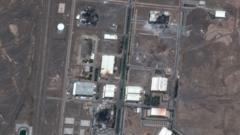In a stark escalation of conflict, Israel has targeted Iranian military sites as Iran retaliates with missile attacks on Israeli cities. This deadly exchange, which has led to significant casualties and regional instability, marks a new chapter in the long-standing enmity between the two nations.
Ongoing Escalation: Iran and Israel's Deadliest Confrontation Yet

Ongoing Escalation: Iran and Israel's Deadliest Confrontation Yet
A brutal exchange has erupted between Iran and Israel, leading to high casualties on both sides and an uncertain future for the region.
---
As regional tensions reach a boiling point, the Israeli military reported on Monday that it had successfully targeted the command center of Iran’s elite Quds Force amid an expanding conflict that has entered its fourth day. Israeli officials estimate the ongoing hostilities could stretch beyond a week as the severity of the attacks intensifies. While Israel aims to eliminate Iran’s nuclear capabilities, Iranian forces are responding with consistent missile strikes against Israeli urban areas, resulting in increasing civilian casualties.
The deadly exchanges have thus far claimed the lives of at least 224 individuals in Iran while also inflicting casualties on the Israeli side, where local authorities report at least 24 deaths. The latest missile barrage from Iran has resulted in devastating impacts on civilian infrastructure, with numerous cities witnessing fatalities and extensive property damage. The Israeli military has claimed it launched numerous strikes against military installations in Iran, primarily aimed at missile launch facilities.
The recent escalations coincide with a broader Israeli strategy that now extends to energy industries crucial to Iran’s economy. Notably, the Iranian missiles have struck various infrastructure, including Israel’s largest oil refinery in Haifa Bay as fierce firefighting efforts continue to mitigate blazes ignited by these attacks. Israeli defense officials assert that the recent airstrikes have significantly eroded Iranian air defense capabilities, attributing their claimed aerial supremacy over Iranian skies to these ongoing military campaigns.
With casualties mounting and no clear diplomatic solutions in sight, the conflict has led to increased instability in the region, raising apprehensions about potential escalations involving outside powers, particularly the United States. Despite recent attempts to negotiate a halt to Iranian nuclear activities, these developments illustrate how quickly diplomatic dialogues can deteriorate into military exchanges, leading both nations deeper into conflict.
As the violence continues and civilian populations become increasingly affected, questions regarding humanitarian aid and support for those displaced by conflict loom large. The crisis remains fluid, with updates on both Iranian and Israeli strategies surfacing continually as the conflict evolves.
As regional tensions reach a boiling point, the Israeli military reported on Monday that it had successfully targeted the command center of Iran’s elite Quds Force amid an expanding conflict that has entered its fourth day. Israeli officials estimate the ongoing hostilities could stretch beyond a week as the severity of the attacks intensifies. While Israel aims to eliminate Iran’s nuclear capabilities, Iranian forces are responding with consistent missile strikes against Israeli urban areas, resulting in increasing civilian casualties.
The deadly exchanges have thus far claimed the lives of at least 224 individuals in Iran while also inflicting casualties on the Israeli side, where local authorities report at least 24 deaths. The latest missile barrage from Iran has resulted in devastating impacts on civilian infrastructure, with numerous cities witnessing fatalities and extensive property damage. The Israeli military has claimed it launched numerous strikes against military installations in Iran, primarily aimed at missile launch facilities.
The recent escalations coincide with a broader Israeli strategy that now extends to energy industries crucial to Iran’s economy. Notably, the Iranian missiles have struck various infrastructure, including Israel’s largest oil refinery in Haifa Bay as fierce firefighting efforts continue to mitigate blazes ignited by these attacks. Israeli defense officials assert that the recent airstrikes have significantly eroded Iranian air defense capabilities, attributing their claimed aerial supremacy over Iranian skies to these ongoing military campaigns.
With casualties mounting and no clear diplomatic solutions in sight, the conflict has led to increased instability in the region, raising apprehensions about potential escalations involving outside powers, particularly the United States. Despite recent attempts to negotiate a halt to Iranian nuclear activities, these developments illustrate how quickly diplomatic dialogues can deteriorate into military exchanges, leading both nations deeper into conflict.
As the violence continues and civilian populations become increasingly affected, questions regarding humanitarian aid and support for those displaced by conflict loom large. The crisis remains fluid, with updates on both Iranian and Israeli strategies surfacing continually as the conflict evolves.




















